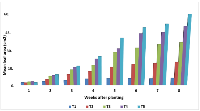Studies on the Allelopathic Effect of Aqueous Extracts of Axonopus compressus (Swartz) P. Beauv on Some Growth Parameters and Phenolic Content of Kalanchoe pinnata (Lam.) Pers.
Keywords:
Allelopathy, Aqeous extract, Axonopus compressus, Phenolic content, Kalanchoe pinnataAbstract
Plant-plant interactions could either be positive (stimulatory) or negative (inhibitory) to one or both plants involved, and the degree/level of positivity or negativity of the effect varies depending on the plants involved in the interaction. Studies were conducted to check the allelopathic effect of a neighbouring weed, Axonopus compressus, on the important medicinal plant, Kalanchoe pinnata, with special emphasis on the effect on its morphology, chlorophyll content, and phenolic content (which is the main active bioconstituent responsible for its medicinal properties). The experiment was carried out in a screenhouse by treating (watering)
Kalanchoe pinnata every two days with 50ml of different concentrations (0%, 25%, 50%, 75%, 100% treatments) of 0.5g/ml stock solution of aqueous extracts of Axonopus compressus; and the parameters studied include shoot length, number of leaves, leaf area,
root length, number of roots, fresh weight, dry weight, total chlorophyll content (TCC) and total phenolic content (TPC) of the treated Kalanchoe pinnata. Results from the experiment showed that, for all parameters studied, the treatments were significantly (P≤0.05) higher than the control. The morphological growth parameters, total chlorophylls content, and phenolic content of K. pinnata showed increased yields compared to the control, thereby establishing that aqueous extract of A. compressus showed a positive (stimulatory)
allelopathic effect on K. pinnata. Therefore, A. compressus could be used as phyto-fertilizer by incorporation into the soil in medicinal gardens, as this could enhance the morphological growth parameters and boost secondary metabolite production of K. pinnata considering its economic uses as an important medicinal plant in Nigeria and Africa at large.
Downloads
References
Anusha, R., Gururaja, M.P., Himanshu, J. and Shastry, C.S. (2014). Kalanchoe pinnatum in treatment of gallstones: an ethnopharmacological review. International Journal of PharmTech Research, 6(1): 252-261.
Azania, A.A.P.M., Azania, C.A.M., Alives, P.L.C.A., Palaniraj, R., Kadian, H.S., Sati, S.C., Rawat, L.S., Dahiya, D.S. and Narwal, S.S. (2003). Allelopathic plants. 7 Barley (Hordeum vulgare L.).Allelopathy Journal 11:1–20.
Cruz EA, Da-Silva SAG, Muzitano MF, Silva PMR, Costa SS, RossiBergmann B. (2008). Immunomodulatory pretreatment
with Kalanchoe pinnata extract and its quercitrin flavonoid effectively protects mice against fatal anaphylactic shock. International Immunopharmacology 8: 1616-21.
Cruz EA, Reuter S, Martin H, Dehzad N, Muzitano MF, Costa SS, RossiBergmann B, Buhl R, Stassend M, Taube C.(2012). Kalanchoe
pinnata inhibits mast cell activation and prevents allergic airway disease. Phytomedicine 19:115-121.
Devbhuti D, Gupta JK, Devbhuti P. (2012). Studies on anti tumour activity of Bryophyllum calycinum Salisb. against Ehrlich ascites carcinoma in Swiss Albino mice. Journal of Pharmaceutical Science and Technology 2: 31-33.
Gaurav, V.H., Chandragauda, R.P. and Mahesh, R.P. (2007). Protective effect of Kalanchoe pinnata Pers. (Crassulaceae) on gentamicininduced nephrotoxicity in rats. Indian Journal of Pharmacology 39(4): 201-205.
Ghani, A. (2003). Monographs of the recorded medicinal plants. Medicinal plants of Bangladesh.2nd ed. Asiatic Society of Bangladesh.
pp. 271-272.
González de Léon, S., Herrera, I. and Guevara, R. (2016). Mating system, population growth and management scenario of
Kalanchoe pinnata in an invaded seasonally dry tropical forest. Ecology and Evolution 6(13): 4541-4550.
Goyal P, Jain N, Panwar NS, Singh GK, Nagori BP. Investigation of hypoglycemic and antidiabetic activities of ethanol extracts of Kalanchoe pinnata leaves in streptozocin-induced diabetic rats. International Journal of Pharmacology and Toxicology
Science 2013; 3: 9-18.
Gupta R, Lohani M, Arora S. (2010). Antiinflammatory activity of the leaf extracts/fractions of Bryophyllum pinnatum Saliv. Syn. International Journal of Pharmaceutical Sciences Review and Research 3:16-18.
Joseph, B., Sridhar, S., Sankarganesh, Justinraj and Edwin, B.T. (2011) Rare medicinal plant – Kalanchoe pinnata. Research Journal of Microbiology 6(4): 322-327.
Lans, C.A. (2006). Ethnomedicines used in Trinidad and Tobago for urinary problems and diabetes mellitus. Journal of Ethnobiology and Ethnomedicine 2: 42-45
Milad, R., El-Ahmady, S. and Singab, A.N. (2014). Genus Kalanchoe (Crassulaceae): A review of its ethnomedicinal, botanical, chemical and pharmacological properties. European Journal of Medicinal Plants 4(1): 86-104.
Musyimi, D.M., Okelo, L.O., Okelo, V.S. and Sikuku, P. (2015). Allelopathic potential of Mexican sunflower (Tithonia diversifolia Hemsl. a Gray) on germination and growth of cowpea seedlings (Vigna sinensis L.). Scientia Agriculturae 12(3): 149-155.
Muzitano, M.F., Tinoco, L.W., Guette, C., Kaiser, C.R., Rossi-Bergmann, B. and Costa, S.S. (2006). The antileishmanial activity assessment of unusual flavonoids from Kalanchoe pinnata. Phytochemistry 67: 2071-2077.
Nayak, B.S., Marshall, J.R. and Isitor, G. (2010). Wound healing potential of ethanolic extract of Kalanchoe pinnata Lam. leaf – a preliminary study. Indian Journal of Experimental Biology 48: 572-576.
Okwu DE and Nnamdi FU. (2011a). Two novel flavonoids from Bryophyllum pinnatum and their antimicrobial activity. Journal of Chemical and Pharmaceutical Research 3: 1-10.
Okwu DE, and Nnamdi FU. (2011b). A novel antimicrobial phenanthrene alkaloid from Bryopyllum pinnatum. Journal of Chemical and Pharmaceutical Research 3: 27-33.
Pisula, N.L. and Meiners, S.J. (2010). Relative allelopathic potential of invasive plant species in a young disturbed woodland. Journal of the Torrey Botanical Society 137(1): 81-87.
Quazi, M.A., Tatiya, A.U., Khurshid, M., Nazim, S. and Siraj, S. (2011). The Miracle Plant (Kalancchoe pinnata): A phytochemical and Pharmacological review. International Journal of Research in Ayurveda and Pharmacy 2(5): 1478-1482.
Rajsekhar, P.B., Bharani, R.S.A., Ramachandran, M., Angel, K.J. and Rajsekhar, S.P.V. (2016). The “wonder plant” Kalanchoe pinnata (Linn.) Pers.: A Review. Journal of Applied Pharmaceutical Science 6(3): 151-158.
Shazid, M.S., Mohammad, K.H., Mohammad, R.H., Abu, A.C., Kaisar, M.A., Choudhury, M.H. and Mohammad, A.R. (2012). Chemical and biological studies of Kalanchoe pinnata (Lam.) growing in Bangladesh. Asian Pacific Journal of Tropical Biomedicine S1317-S1322.
Sumanta, N. Haque, C.I., Nishika, J. and Suprakash, R. (2014). Spectrophotometric analysis of chlorophylls and carotenoids from commonly grown fern species by using various extracting solvents. Research Journal of Chemical Sciences 4(9): 63-69.
Sunita, M. and Dhananjay, S. (2010). Quantitative analysis of Total Phenolic Content of Adhatoda vasica Nees extracts. International Journal of PharmTech Research 2(4): 2403-2406.
Supratman U, Fujita T, Akiyama K, Hayashi H. (2000). New insecticidal bufadienolide, bryophyllin C, from Kalanchoe pinnata. Bioscience, Biotechnology and Biochemistry 64: 1310-1312.
Supratman U, Fujita T, Akiyama K, Hayashi H, Murakami A, Sakai H, Koshimizu K, Ohigashi H. (2001). Anti-tumour promoting activity of bufadienolides from Kalanchoe pinnata and K. daigremontiana × tubiflora. Bioscience, Biotechnology and Biochemistry 65: 947-949.
Uzoma, M.C., Mensah, S.I. and Ochekwu, E.B. (2018). Allelopathic effect of aqueous extracts of Axonopus compressus (Swartz) P. Beauv on the chlorophylls and phenolic content of Kalanchoe pinnata (Lam.) Pers. Nigerian Journal of Agricultural Technology 15(1): 22-26.
Weigelt, A. and Jolliffe, P. (2003). Essay review – Indices of Plant Competition. Journal of Ecology 91:707-720.
Yadav, N.P. and Dixit, V.K. (2003). Hepatoprotective activity of leaves of Kalanchoe pinnata Pers. Journal of Ethnopharmacology 86: 197-202.
Zhang, C. and Fu, S. (2009). Allelopathic effects of eucalyptus and the establishment of mixed stands of eucalyptus and native species. Forest Ecology and Management 258: 1391–1396.

Downloads
Published
Issue
Section
License

This work is licensed under a Creative Commons Attribution-NonCommercial-ShareAlike 4.0 International License.







